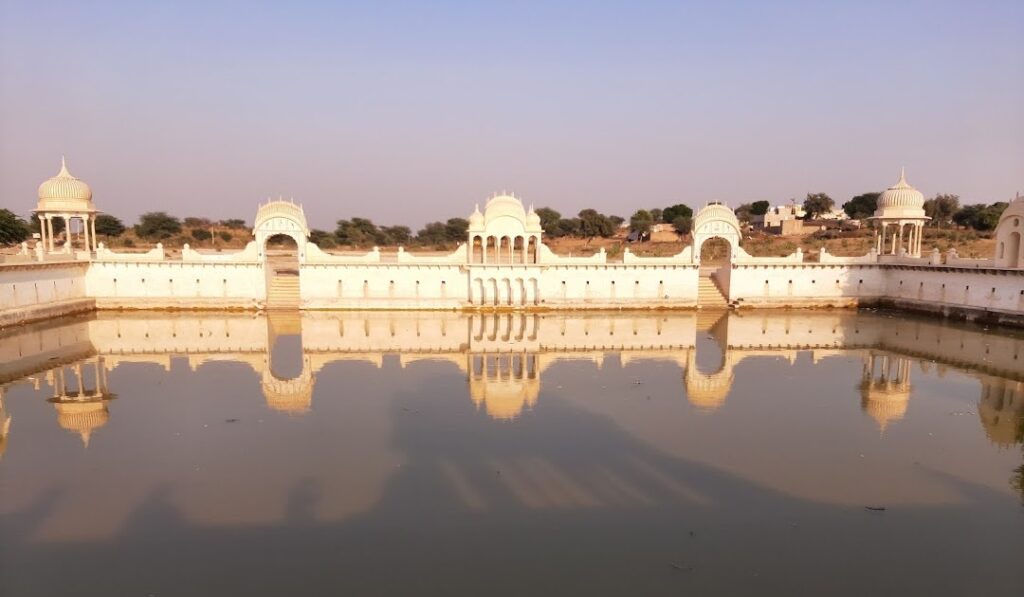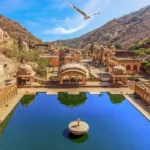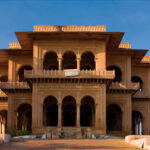Discovering the Majestic Ganga Maharani Temple in Bharatpur
Nestled in the vibrant city of Bharatpur, Rajasthan, the Ganga Maharani Temple stands as a wonderful tribute to the divine mother, Goddess Ganga. This temple, with its intricate style and spiritual value, is not just a place of worship but also a beacon of cultural heritage and history. In this article, we will delve into the rich history, architectural beauty, and spiritual ambiance of the Ganga Maharani Temple, providing a comprehensive guide for travelers and devotees alike.
A Peek into History
The Ganga Maharani Temple, dedicated to Goddess Ganga, was built by Maharaja Balwant Singh of Bharatpur in the mid-19th century. The temple was constructed in 1845 during the reign of Maharaja Balwant Singh, a prominent ruler of the Jat dynasty in Bharatpur. The temple is not just a religious monument but also a testament to the devotion of the Maharaja and the people of Bharatpur towards the river goddess, who is revered in Hindu mythology as the purifier of sins and the sustainer of life.
The temple’s history is deeply intertwined with the culture and traditions of Bharatpur. It has been a place of pilgrimage for devotees from various parts of India, who visit to seek the blessings of Goddess Ganga. The temple also reflects the rich heritage of Bharatpur, a city known for its royal legacy and historical significance.
Architectural Wonder
The Ganga Maharani Temple is an architectural marvel that showcases a blend of traditional Rajasthani and Mughal architectural styles. The temple’s structure is adorned with intricate carvings and exquisite sculptures, making it a visual delight for art and architecture enthusiasts.
The temple complex is built on a raised platform and is surrounded by beautifully landscaped gardens. The main entrance is adorned with an intricately carved archway, leading to the sanctum sanctorum where the idol of Goddess Ganga is enshrined. The idol is beautifully crafted in white marble, symbolizing purity and divinity.
The temple’s façade is adorned with detailed carvings depicting various deities and mythological scenes. The walls and ceilings of the temple are decorated with vibrant frescoes and paintings, showcasing the artistic excellence of the craftsmen of that era. The temple also features a majestic dome, which is a common feature in many Mughal-style structures. The dome is embellished with delicate carvings and is topped with a kalash (sacred pot), a symbol of prosperity and auspiciousness in Hindu culture.
Spiritual Significance
The Ganga Maharani Temple holds immense spiritual significance for Hindus. Goddess Ganga is considered the goddess of purification and is believed to cleanse the sins of those who seek her blessings. Devotees visit the temple to offer prayers and seek blessings for health, prosperity, and spiritual well-being.
The temple is also a focal point for various religious ceremonies and festivals. One of the most significant festivals celebrated at the temple is the Ganga Dussehra, which marks the descent of Goddess Ganga from heaven to earth. During this festival, the temple is beautifully decorated, and devotees gather to participate in the special rituals and prayers.
Another important event is the annual Navratri festival, a nine-day celebration dedicated to the nine forms of the goddess. The temple becomes a hub of spiritual activities, with devotees participating in various rituals, including the offering of flowers, lighting of lamps, and chanting of hymns. The temple also organizes community meals (bhandaras) during these festivals, where devotees can partake in the prasadam (sacred food) offered to the goddess.
A Place of Serenity and Reflection
Beyond its architectural beauty and spiritual significance, the Ganga Maharani Temple offers a serene and tranquil atmosphere for visitors. The temple’s peaceful surroundings, with lush gardens and the soothing sound of temple bells, provide a perfect setting for meditation and reflection.
The temple’s serene ambiance attracts not only devotees but also tourists and travelers seeking a moment of peace and solitude. The well-maintained gardens surrounding the temple offer a refreshing escape from the hustle and bustle of city life. Visitors can take leisurely strolls through the gardens, enjoying the scenic beauty and the fragrance of blooming flowers.
Visiting the Ganga Maharani Temple
The Ganga Maharani Temple is located in the heart of Bharatpur, making it easily accessible for visitors. The temple is open to devotees and tourists throughout the year, with special arrangements made during festivals and religious events. The best time to visit the temple is during the early morning or late evening when the temple is less crowded, and the ambiance is most serene.
For those planning a visit, it is advisable to dress modestly and adhere to the temple’s customs and traditions. Photography is generally allowed in the temple premises, but visitors are advised to respect the sanctity of the temple and seek permission before taking photographs inside the sanctum sanctorum.
Conclusion
The Ganga Maharani Temple in Bharatpur is not just a place of worship but a symbol of cultural heritage, architectural grandeur, and spiritual devotion. Its rich history, exquisite architecture, and serene ambiance make it a must-visit destination for anyone traveling to Bharatpur. Whether you are a devotee seeking blessings or a traveler exploring the historical and cultural treasures of Rajasthan, the Ganga Maharani Temple offers a unique and enriching experience that will leave a lasting impression on your mind and soul.
For more information about exploring Rajasthan, including the best travel packages and accommodations, visit Rajasthan Tour Packages.
Q1.: That developed the Ganga Maharani Holy Place and when?
A: The Ganga Maharani Holy place was constructed by Maharaja Balwant Singh of Bharatpur in 1845.
The Ganga Maharani Temple, dedicated to Goddess Ganga, was created during the reign of Maharaja Balwant Singh, a noticeable leader of the Jat dynasty in Bharatpur. The temple is not just a religious monument however likewise a testament to the commitment of the Maharaja and the people of Bharatpur towards the river siren, that is admired in Hindu folklore as the cleanser of sins and the sustainer of life.
Q2.: What is the historical significance of the temple?
A: The temple’s background is deeply linked with the culture and practices of Bharatpur. It has actually been a place of expedition for devotees from different parts of India, who visit to seek the true blessings of Siren Ganga. The holy place additionally shows the abundant heritage of Bharatpur, a city known for its imperial legacy and historic significance.
Architectural Wonder
Q3.: What architectural designs are seen in the Ganga Maharani Holy Place?
A: The temple showcases a mix of standard Rajasthani and Mughal architectural designs.
The Ganga Maharani Temple is a building marvel adorned with detailed makings and charming sculptures, making it an aesthetic delight for art and design fanatics. The holy place facility is built on a raised platform and is surrounded by wonderfully designed gardens. The primary entryway is adorned with an intricately carved archway, resulting in the sanctum sanctorum where the idolizer of Siren Ganga is preserved.
Q4.: Describe the idolizer and designs within the temple.
A: The idol is beautifully crafted in white marble, signifying purity and divinity. The temple’s appearance is decorated with comprehensive makings illustrating various divine beings and mythical scenes. The walls and ceilings of the temple are enhanced with lively frescoes and paintings, showcasing the imaginative quality of the craftsmen of that age. The temple also includes an impressive dome, which is an usual attribute in several Mughal-style frameworks. The dome is embellished with delicate makings and is covered with a kalash (sacred pot), an icon of prosperity and auspiciousness in Hindu culture.
Spiritual Importance
Q5.: What spiritual importance does the holy place hold?
A: The Ganga Maharani Holy place holds tremendous spiritual significance for Hindus. Goddess Ganga is considered the siren of purification and is believed to cleanse the transgressions of those who seek her true blessings. Followers see the holy place to offer petitions and look for true blessings for health and wellness, prosperity, and spiritual health.
Q6.: Which significant events are celebrated at the holy place?
A: The temple is a focal point for various religious events and celebrations, including the Ganga Dussehra and Navratri event. The Ganga Dussehra notes the descent of Siren Ganga from paradise to earth, and during this celebration, the temple is beautifully enhanced. Navratri is a nine-day celebration dedicated to the nine forms of the goddess. The holy place ends up being a hub of spiritual tasks, with enthusiasts participating in different rituals, including the offering of blossoms, lights of lights, and chanting of hymns. The temple likewise organizes area meals (bhandaras) throughout these events, where followers can partake in the prasadam (spiritual food) offered to the goddess.
An Area of Serenity and Reflection
Q7.: What environment does the Ganga Maharani Holy place offer?
A: Beyond its building elegance and spiritual value, the Ganga Maharani Temple supplies a calm and tranquil atmosphere for site visitors. The holy place’s calm environments, with lush gardens and the calming audio of holy place bells, give an ideal setup for reflection and reflection.
Q8.: Why do travelers see the holy place?
A: The holy place’s serene ambiance brings in not only supporters yet additionally travelers and tourists seeking a minute of peace and privacy. The well-maintained yards bordering the temple provide a rejuvenating escape from the hustle and bustle of city life. Visitors can take leisurely walks via the gardens, enjoying the picturesque beauty and the scent of flowering blossoms.
Going To the Ganga Maharani Holy Place
Q9.: Where is the Ganga Maharani Holy place located, and when is the best time to check out?
A: The Ganga Maharani Holy place is located in the heart of Bharatpur, making it quickly available for visitors. The holy place is open to devotees and vacationers throughout the year, with special arrangements made during events and spiritual events. The very best time to go to the holy place is throughout the early morning or late evening when the holy place is less jampacked and the setting is most tranquil.
Q10.: Exist any type of guidelines for site visitors?
A: For those preparing a visit, it is recommended to dress decently and adhere to the holy place’s custom-mades and traditions. Photography is generally allowed on the temple properties, but visitors are suggested to appreciate the solemnity of the temple and look for approval prior to taking photographs inside the sanctum sanctorum.



